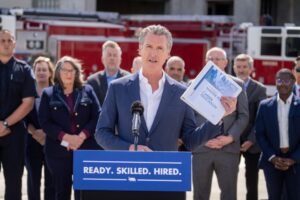
California governor’s new career education plan ‘prioritizes hands-on learning and real-life skills’
By onAnnouncements
California Gov. Gavin Newsom says a new education plan for the state will “strengthen career pathways, prioritize hands-on learning and real-life skills, and advance educational access and affordability,” according to a press release from his office.
The release says the “Master Plan for Career Education” will be supported by proposed budget investments and make it easier for Californians to receive college credit for real-world experience including veterans. It was unveiled April 2 at Modesto Junior College.
“With strategic input from agencies and community members, two central themes emerged to guide the creation of the Master Plan: enhance coordination and address structural barriers that make it difficult for Californians to navigate education, workforce training, and public benefit systems,” the release states.
“By designing systems so they are inherently accessible to all learners regardless of their varied needs and circumstances, California can simultaneously expand access for a wide variety of learners and free up resources to provide more customized support for specific populations.”
In August 2023, Newsom called for a new master plan through his “Freedom to Succeed” executive order, urging state agencies and institutions of higher education to increase equitable access to well-paid jobs.
The plan will be carried out through six primary areas of action:
-
- “Create a state planning and coordinating body;
- “Strengthen regional coordination;
- “Support skills-based hiring through Career Passport;
- “Develop career pathways for high school and college students;
- “Strengthen workforce training for young people and adults; and
- “Increase access to and affordability of education and workforce training”
According to the release, Newsom’s January budget includes several proposals that stem from the master plan, including Career Passport — a digital tool that gathers academic records with verified experience from work, military service, training programs, and more.
Nonprofit news organization CalMatters reports that “California faces stark income inequality, its jobs are increasingly automated and the degrees from its state’s universities are no longer the asset they once were.”
The statewide push is expected to benefit 250,000 people, including 30,000 veterans, and generate billions in long-term economic gains by speeding up time to a degree and cutting costs, the release states. The plan invests in expanding Credit for Prior Learning (CPL) allowing veterans and working Californians to turn real-world experience into college credit.
“The Master Plan lays out a clear path to help all Californians — whether just starting out or switching careers — access high-paying, fulfilling jobs, with or without a college degree,” said Newsom. “By aligning our education system with real workforce needs, we’re powering economic growth and creating stronger communities.”
To make career pathways more effective, the plan calls for a new statewide collaborative to align education, training, and hiring needs which will help track labor market trends, reduce duplication, build smarter workforce strategies, and better support students throughout their educational careers. CalMatters reports that will come at a cost of $5 million.
The plan aims to support stronger regional partnerships as well by expanding paid internships, streamlining funding, and engaging employers, according to the release.
However, the plan isn’t fully approved yet.
“[C]ertain aspects of the plan will need approval from the legislature, and it’s not clear whether that will happen,” the CalMatters article states. “Legislators and the Legislative Analyst’s Office have criticized the governor’s new proposals as ‘unproven’ and ‘unclear.’
“The plan highlights ongoing efforts, such as the state’s new education data system, its recent reforms to financial aid, and the expansion of skills-based learning at community colleges, known as competency-based education. That data system is behind schedule, and the financial aid reforms only arose after CalMatters wrote about the governor’s failure to implement them. Seven community colleges are moving forward with competency-based education, per the governor’s wishes — but at one school, Madera Community College, the reforms have stalled due to faculty opposition.”
According to the plan, California has one of the widest gaps in income distribution in the country. The top 10%, those who make an average of more than $300,000 per year, earn 10 times more than families at the bottom 10% of the scale, who make $29,000.
During the Society of Collision Repair Specialists (SCRS) 2024 IDEAS Collide Showcase, held at the SEMA Show in Las Vegas, Molly Mahoney, Collision Engineering Program (CEP) national marketing and engagement director, shared her perspectives on the power of the industry coming together.
There is a growing demand for skilled collision repair technicians. Mahoney addressed how the CEP uses its vision to harness a powerful collaboration between education, industry, and local communities to bring new technicians into the industry.
It was also said during the showcase that it’s important for repairers to get involved with state and national associations to change policies and support each other, and educate with real-world participation for the industry’s future, such as through apprenticeships.
Images
Featured image: California Gov. Gavin Newsom speaks on April 2, 2025 about the state’s new “Master Plan for Career Education” during a press conference at Modesto Junior College. (Photo provided by Newsom’s Office)
